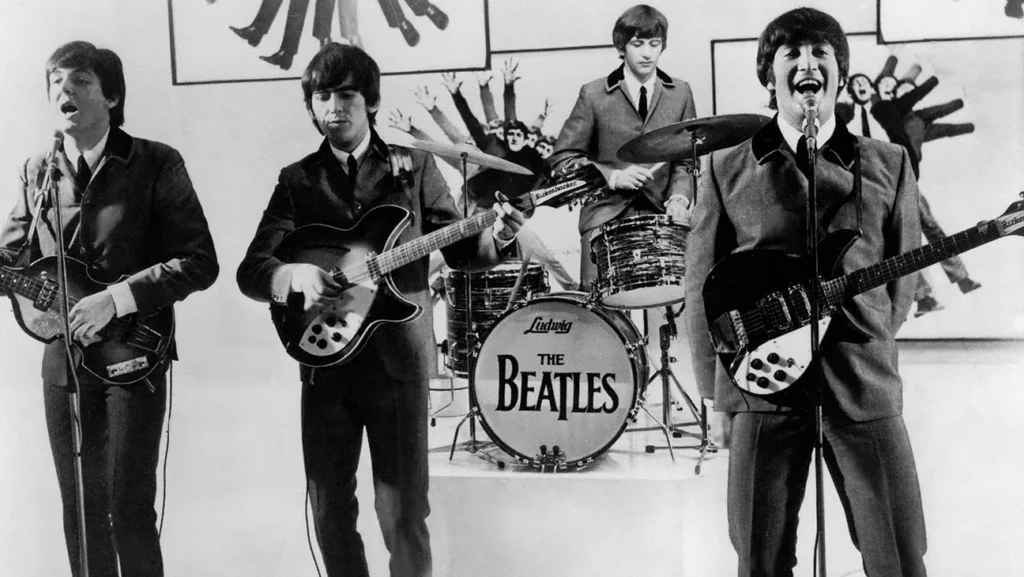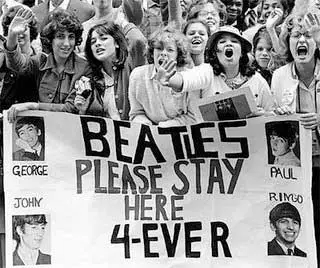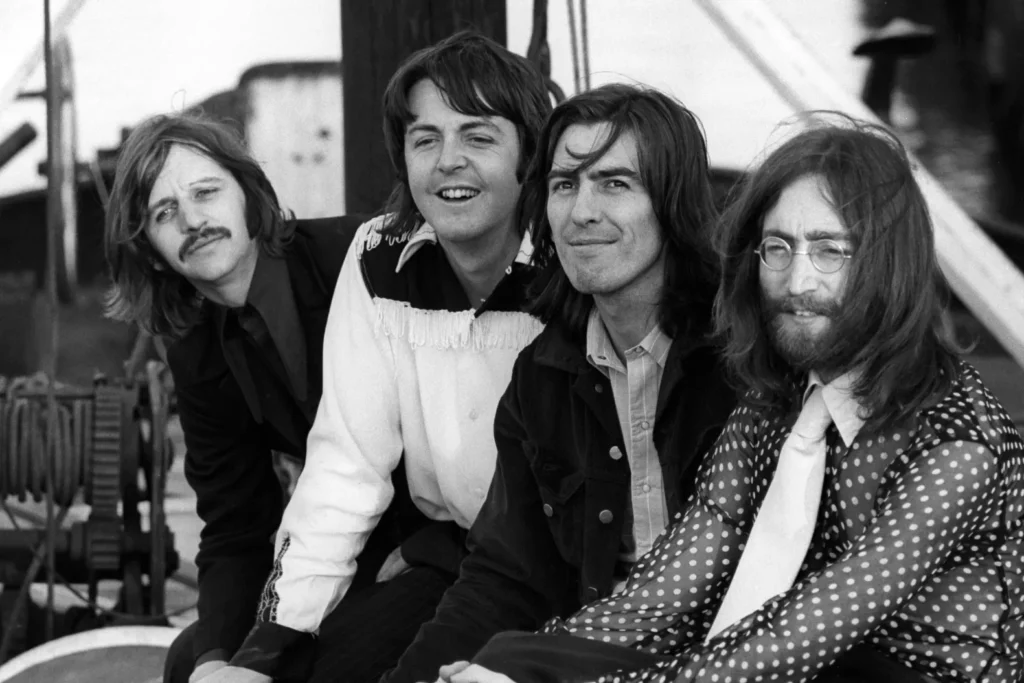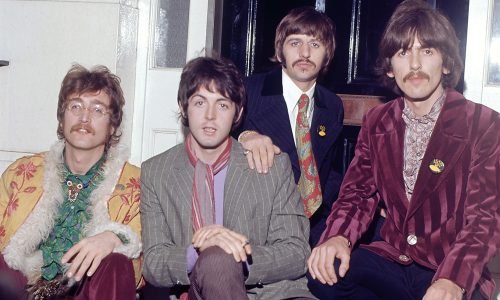In the realm of modern music, few names resonate as profoundly as the Beatles. Emerging from the vibrant streets of Liverpool, this quartet not only captured the hearts of millions but also redefined the musical landscape of the 20th century. From their infectious early hits to their groundbreaking later works, the Beatles’ influence on both pop and rock music is undeniable, sparking a cultural revolution that continues to inspire artists today.
The debate over whether the Beatles were primarily a pop or rock band has intrigued fans and critics alike for decades. Were they the charming pop icons who penned timeless melodies like “I Want to Hold Your Hand,” or were they the pioneering rockers who crafted revolutionary albums like “Sgt. Pepper’s Lonely Hearts Club Band“? This question is not just about categorizing their music but understanding the essence of their artistic journey and its impact on the broader music industry.
Historical Context

Formation and Early Years
The Beatles’ story begins in the bustling port city of Liverpool, England, where four young musicians—John Lennon, Paul McCartney, George Harrison, and Ringo Starr—came together to form what would become one of the most influential bands in history. The seeds of the Beatles were sown in 1957 when a teenage John Lennon met Paul McCartney at a church fete. Their mutual love for skiffle music, a genre blending jazz, blues, and folk, laid the foundation for their early sound. George Harrison soon joined, bringing his guitar prowess to the group, and after a few lineup changes and a stint in Hamburg’s gritty club scene, Ringo Starr completed the classic lineup in 1962.
The Beatles’ early years were heavily influenced by American rock and roll and rhythm and blues. Artists like Elvis Presley, Chuck Berry, and Buddy Holly provided the blueprint for their energetic performances and catchy melodies. These influences were evident in their early recordings, which combined the raw energy of rock and roll with the harmonious vocal style of doo-wop groups.
Cultural Landscape
The 1960s music scene was a period of remarkable transformation and diversification. At the dawn of the decade, pop music was dominated by polished, radio-friendly acts like the Everly Brothers and Pat Boone. This era was characterized by its clean-cut image and catchy, simple melodies designed for mass appeal. Pop music was the sound of youth and optimism, often focusing on themes of love and teenage life.
In contrast, rock music began to emerge as a distinct and more rebellious genre. The rock scene was marked by its edgier sound, driven by electric guitars, prominent backbeats, and a more aggressive vocal style. The lyrics often tackled deeper and more provocative subjects, including social issues, personal freedom, and existential angst. Bands like the Rolling Stones and the Who epitomized this new wave of rock, challenging the status quo and pushing musical boundaries.
As the 1960s progressed, the lines between pop and rock began to blur. The Beatles were at the forefront of this cultural shift, initially embraced as pop darlings with their matching suits and infectious harmonies. However, their relentless creativity and willingness to experiment soon led them into the rock arena, where they explored new sounds, recording techniques, and lyrical themes. This evolution mirrored the broader changes in the music industry, where genres became less rigid, and artists felt freer to innovate.
Musical Evolution

Early Pop Sensibilities
The Beatles’ early hits, such as “Please Please Me” and “She Loves You,” are quintessential examples of 1960s pop music. Released in 1963, “Please Please Me” was their breakthrough single in the UK, showcasing their knack for crafting infectious melodies and tight harmonies. The song’s upbeat tempo, catchy chorus, and straightforward lyrics about young love made it an instant hit. “She Loves You,” released later that same year, further cemented their status as pop icons. With its memorable “Yeah, yeah, yeah” refrain, the song epitomized the exuberance of early 60s pop, blending youthful energy with polished production.
These early tracks were marked by their simplicity and accessibility, hallmarks of the pop genre. The Beatles’ clean-cut image, coordinated outfits, and charming stage presence resonated with a broad audience, particularly teenage girls. Their music was crafted for mass appeal, with clear, relatable themes and a sound that was both fresh and familiar. This period of their career was defined by their ability to produce hit after hit, dominating the charts with songs that became instant classics.
Transition to Rock
The Beatles’ mid-career marked a significant shift in their musical direction, as evidenced by albums like “Rubber Soul” (1965) and “Revolver” (1966). These records showcased their growing sophistication as songwriters and their willingness to experiment with different sounds and styles, moving beyond the straightforward pop formula.
“Rubber Soul” was a turning point, featuring songs like “Norwegian Wood (This Bird Has Flown)” and “In My Life.” The use of a sitar on “Norwegian Wood” introduced a new sonic element, reflecting George Harrison’s interest in Indian music. The lyrics also became more introspective and complex, exploring themes of love, loss, and self-reflection. “In My Life,” with its baroque-inspired piano solo, demonstrated their expanding musical palette and innovative approach to arrangements.
“Revolver” took their experimentation even further. Tracks like “Eleanor Rigby” and “Tomorrow Never Knows” pushed the boundaries of what rock music could be. “Eleanor Rigby,” with its string quartet arrangement, abandoned traditional rock instrumentation entirely, while “Tomorrow Never Knows” utilized tape loops, backward recordings, and psychedelic effects, creating a sound that was ahead of its time. These albums were crucial in establishing the Beatles as pioneers of rock music, blending pop sensibilities with experimental techniques and diverse influences.
Late Experimental Phase
The Beatles’ late experimental phase is epitomized by albums such as “Sgt. Pepper’s Lonely Hearts Club Band” (1967) and “The White Album” (1968). These records showcased their mastery of studio technology and their willingness to blend rock, psychedelia, and other genres into a cohesive yet eclectic sound.
“Sgt. Pepper’s Lonely Hearts Club Band” is often hailed as one of the greatest albums of all time, a landmark in the history of rock music. The album’s concept, presenting the Beatles as an alter-ego band, allowed them to explore a wide range of musical styles and themes. Songs like “Lucy in the Sky with Diamonds” and “A Day in the Life” exemplify their psychedelic influences, with surreal lyrics and innovative production techniques. The use of orchestras, sound effects, and unconventional instruments created a rich, textured sound that was both groundbreaking and influential.
“The White Album” represented a more fragmented and diverse approach, with each member contributing distinct styles and ideas. From the hard rock of “Helter Skelter” to the gentle folk of “Blackbird” and the avant-garde sound collage of “Revolution 9,” the album defied genre conventions, showcasing their versatility and creative freedom. This period was marked by a fearless exploration of new musical territories, blending elements of rock, pop, folk, blues, and avant-garde to create something entirely unique.
Songwriting and Instrumentation

Pop Elements
The Beatles’ early success was built on their mastery of pop music elements, particularly in their melodies, harmonies, and lyrical themes. Their knack for crafting catchy, memorable tunes was evident from the outset. Songs like “I Want to Hold Your Hand” and “All My Loving” feature infectious melodies that stick in the listener’s mind long after the song has ended. These melodies, often characterized by their simplicity and singability, were a key factor in the Beatles’ widespread appeal.
Harmonies played a crucial role in the Beatles’ pop sound. John Lennon and Paul McCartney’s vocal interplay, often joined by George Harrison, created rich, layered harmonies that added depth to their songs. Tracks like “If I Fell” and “This Boy” showcase their skill in blending voices, a technique that was both a nod to their influences from earlier vocal groups and a distinctive element of their style.
Lyrically, the Beatles’ early work revolved around themes of love, relationships, and youthful experiences. Songs such as “She Loves You” and “Can’t Buy Me Love” capture the excitement and simplicity of young love, resonating with the teenage audience of the time. Their lyrics were direct and relatable, contributing to their pop sensibilities and mass appeal.
Rock Characteristics
As the Beatles evolved, their music began to incorporate more rock characteristics, especially in terms of instrumentation, song structure, and lyrical content. The transition from pop to rock was marked by their increasing use of electric guitars, bass, and drums to create a harder-edged sound. Songs like “Ticket to Ride” and “Day Tripper” feature prominent electric guitar riffs, more aggressive rhythms, and a heavier sound overall, distinguishing them from their earlier, lighter pop tunes.
The song structures also became more complex. While early Beatles songs often followed the traditional verse-chorus format, their later work experimented with unconventional arrangements and varied sections. For instance, “A Day in the Life” from “Sgt. Pepper’s Lonely Hearts Club Band” combines distinct parts written by Lennon and McCartney, creating a multi-faceted composition that defies simple categorization.
Lyrically, the Beatles began to explore deeper and more diverse themes, moving beyond the straightforward love songs of their early career. Tracks like “Norwegian Wood (This Bird Has Flown)” and “Eleanor Rigby” delve into more introspective and sometimes darker subject matter, reflecting personal experiences and societal observations. This lyrical maturity was accompanied by more sophisticated and sometimes experimental instrumentation, including the use of sitar, strings, and unconventional recording techniques.
Their later albums, such as “Revolver” and “The White Album,” further showcase their rock credentials. “Revolver” includes songs like “Tomorrow Never Knows,” which uses tape loops and backward guitar solos to create a psychedelic rock sound, while “Helter Skelter” from “The White Album” is often cited as one of the earliest examples of heavy metal due to its raw energy and intense instrumentation.
Cultural Impact and Legacy

Pop Culture Phenomenon
The Beatles were not just a band; they were a global pop culture phenomenon that redefined the music industry and left an indelible mark on society. From their first appearance on “The Ed Sullivan Show” in 1964, they captivated audiences with their charm, wit, and infectious music. This televised performance reached an estimated 73 million viewers, solidifying the Beatles as a household name and triggering the “British Invasion” of the American music scene.
Their media presence was unparalleled. The Beatles’ every move was documented, from their hairstyles to their opinions on world events, making them the first band to achieve such pervasive cultural omnipresence. Their films, such as “A Hard Day’s Night” and “Help!,” further showcased their personalities and broadened their appeal beyond music. Beatlemania, the term coined to describe the intense fan frenzy surrounding them, exemplified their unprecedented influence. Fans, particularly young women, followed them with fervent devotion, illustrating the band’s ability to connect on a personal and emotional level.
The Beatles’ role in shaping pop culture extended to fashion, language, and lifestyle. Their evolution from clean-cut suits to psychedelic attire mirrored and influenced broader social changes. Phrases like “Beatlemania” and “Fab Four” entered the cultural lexicon, and their impact on youth culture was profound, promoting ideals of peace, love, and creative expression.
Rock Icons
While the Beatles began as pop sensations, their influence on rock music is equally significant. As they experimented with new sounds and recording techniques, they pushed the boundaries of what rock music could be. Albums like “Rubber Soul” and “Revolver” showcased their willingness to innovate, incorporating elements of folk rock, psychedelic rock, and even classical music.
Their experimentation laid the groundwork for the development of various rock subgenres. The Beatles’ use of non-traditional rock instruments, such as the sitar in “Norwegian Wood” and the string quartet in “Eleanor Rigby,” broadened the sonic possibilities for rock bands. Their embrace of studio techniques, like tape loops and backward recordings in “Tomorrow Never Knows,” influenced countless musicians and producers, encouraging a more experimental approach to rock music.
Subsequent rock bands have often cited the Beatles as a primary influence. The Rolling Stones, The Who, Led Zeppelin, and Pink Floyd all drew inspiration from the Beatles’ innovative spirit and musical diversity. The Beatles’ ability to evolve and push the artistic envelope became a blueprint for bands aiming to achieve longevity and artistic integrity in the rock genre.
Genre Blending
One of the Beatles’ most enduring legacies is their ability to blur the lines between pop and rock, creating a new musical paradigm. They demonstrated that these genres were not mutually exclusive but could coexist and enrich one another. This genre blending is evident throughout their career, from the pop-rock hybrids of their early albums to the sophisticated fusion of styles in their later works.
“Sgt. Pepper’s Lonely Hearts Club Band” is a prime example of this genre-blending approach. The album merges rock’s experimental edge with pop’s melodic sensibility, incorporating elements of classical music, vaudeville, and Eastern influences. This eclecticism created a rich tapestry of sound that defied simple classification and set a new standard for what an album could be.
Their ability to seamlessly integrate different genres also paved the way for future artists to explore and innovate without fear of being pigeonholed. Bands like Radiohead, Oasis, and U2 have followed in their footsteps, creating music that transcends genre boundaries and appeals to a wide range of listeners.
Closing Thoughts

Throughout their career, the Beatles exemplified an extraordinary musical evolution that blurred the lines between pop and rock. Their early years were characterized by catchy melodies, tight harmonies, and relatable lyrics that made them pop sensations. As they matured, their music began to incorporate more rock elements, such as complex instrumentation, innovative song structures, and deeper, more introspective lyrics. Albums like “Rubber Soul” and “Revolver” showcased their willingness to experiment and push the boundaries of rock music, while “Sgt. Pepper’s Lonely Hearts Club Band” and “The White Album” demonstrated their mastery of genre blending. Their cultural impact extended beyond music, influencing fashion, language, and lifestyle, and inspiring countless artists across various genres.
Final Verdict
While the Beatles began as pop icons, their enduring legacy and profound influence on music ultimately align them more closely with rock. Their mid to late career albums introduced a level of sophistication, experimentation, and depth that transcended traditional pop music. By pushing the boundaries of what rock music could encompass, the Beatles redefined the genre and inspired countless artists to explore new creative horizons. Their embrace of rock’s rebellious spirit, combined with their innovative use of studio technology and complex compositions, solidifies their status as a rock band at their core. Therefore, despite their pop beginnings, the Beatles’ transformative impact on rock music is undeniable, and they should be recognized as a rock band that revolutionized the genre.
The Beatles’ legacy is a testament to their unparalleled ability to innovate and influence. Their journey from pop idols to rock pioneers reshaped the musical landscape, proving that artistic growth and commercial success can go hand in hand. They broke down the barriers between genres, creating a rich and diverse body of work that continues to inspire and resonate with new generations of listeners. The Beatles’ impact on the music industry is profound and enduring, solidifying their place as one of the greatest bands of all time. Their music, characterized by its timeless appeal and innovative spirit, remains a cornerstone of both pop and rock, illustrating the transformative power of blending these two genres.
